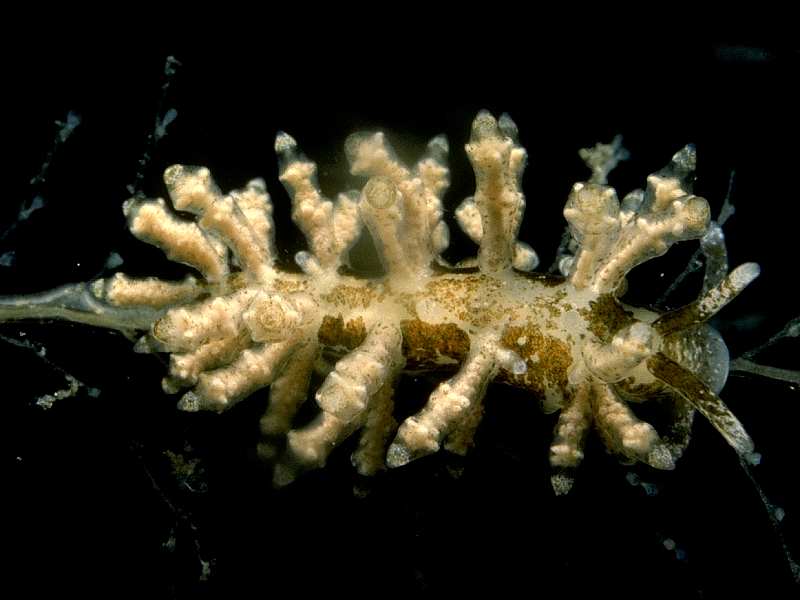Northern Ireland Priority species (NIPS)
| MOLLUSCA : Nudibranchia : Eubranchidae | SNAILS, SLUGS, ETC. |
Capellinia fustifera (Lovén, 1846)
 |
| Capellinia fustifera |
This cryptic sea slug is rare in Northern Ireland, and possibly under-recorded, being only found off the north coast.
In brief
- This species is rare in Northern Ireland, being found only off the north coast
- Northern Ireland is the UK stronghold for this species
- It can only be seen by diving
- Threats to this species are unknown, as there is little knowledge of the current populations in Britain and Ireland.
Species description: This is a small nudibranch sea slug, with adults only growing to about 12mm. The body is translucent white, with scattered brown or green pigment on the back and cerata. The cerata have two to three rows of tubercles giving an irregular knobbly appearance. The tip of each ceras is covered by a pale patch, and encircled by a brown-coloured ring. The rhinophoral and oral tentacles are smooth; the tips of these tentacles are white with a subterminal brown band.
Life cycle: As with all nudibranch sea slugs, Eubranchus doriae is a hermaphrodite. The spawn is a flared cup-like circle of white ribbon with a basal pad attaching it to the stem of its hydroid prey. Spawning normally takes place in November.
Similar species: There are two similar species: Eubranchus exiguus and E. vittatus. Eubranchus doriae may be easily distinguished from E. vittatus by the presence of tubercles on the cerata. Eubranchus exiguus has few cerata, which are urn-shaped, and is usually found on Obelia sp. attached to kelp.
How to see this species: This species has only been found off the Skerries (near Portrush) and Fair Head in Northern Ireland, in depths of 18-31m between 1982 and 1985 in July and August. It lives on mixed substrates of bedrock, boulders and pebbles. It is carnivorous, feeding on the plumularian hydroid Kirchenpaueria similis.
Current status: This species has not been seen in Northern Ireland since 1985. It is rare in Northern Ireland, being only found at the Skerries and Fair Head. It has been located elsewhere in the Republic of Ireland from Mulroy Bay, County Donegal south down the west coast, to Lough Hyne, County Cork. It also occurs on the south and western coasts of Britain, although it has been found as far north as St. Kilda, and elsewhere the Atlantic coast of France and the Mediterranean. It is probably under-recorded.
Why is this species a priority in Northern Ireland?
- This species is rare with Northern Ireland being the UK stronghold for this species.
Threats: Threats to this species are unknown, as there is little knowledge of the current populations in Britain and Ireland.
Distribution Map from NBN: Capellinia fustifera at National Biodiversity Network mapping facility, data for UK.
iNaturalist: Capellinia fustifera at iNaturalist World Species Observations database.
WoRMS: Capellinia fustifera at World Register of Marine Species. Accepted name: Capellinia fustifera (Lovén, 1846). AphiaID: 1339732.
Classification: Biota; Animalia; Mollusca; Gastropoda; Heterobranchia; Euthyneura; Ringipleura; Nudipleura; Nudibranchia; Cladobranchia; Fionoidea; Eubranchidae; Capellinia
| Previous species | Next species |
| Authors (2024). Capellinia fustifera. (Lovén, 1846). [In] Priority species, Marine Biodiversity Portal NI. https://www2.habitas.org.uk/marbiop-ni/priorityaccounts.php?item=W15110. Accessed on 2025-04-19 |